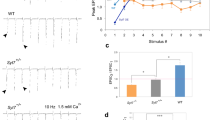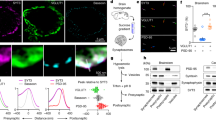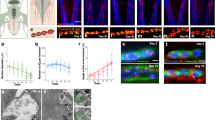Abstract
The GTPase dynamin is involved in endocytosis in many cell types1, as first revealed by temperature-sensitive paralytic mutations in the Drosophila dynamin gene, shibire (shi), which disrupt synaptic vesicle endocytosis and deplete synaptic terminals of vesicles2,3,4,5,6. Here we report that shi synapses exhibit a fast synaptic fatigue phenotype within 20 ms of repetitive stimulation, which cannot be explained by vesicle depletion, as we confirmed by electron microscopy. These results suggest that, in addition to its well-characterized role in synaptic vesicle recycling, dynamin may be required for short-term maintenance of the readily releasable pool of synaptic vesicles.
This is a preview of subscription content, access via your institution
Access options
Subscribe to this journal
Receive 12 print issues and online access
$209.00 per year
only $17.42 per issue
Buy this article
- Purchase on Springer Link
- Instant access to full article PDF
Prices may be subject to local taxes which are calculated during checkout


Similar content being viewed by others
References
Schmid, S. L., McNiven, M. A. & De Camilli, P. Curr. Opin. Cell Biol. 10, 504 –512 (1998).
Kosaka, T. & Ikeda, K. J. Neurobiol. 14, 207–225 (1983).
Poodry, C. A. & Edgar, L. J. Cell Biol. 81, 520–527 (1979).
Salkoff, L. & Kelly, L. Nature 273, 156–158 (1978).
Costello, W. J. & Salkoff, L. B. J. Neurosci. 6, 3634–3639 (1986).
Ramaswami, M., Krishnan, K. S. & Kelly, R. B. Neuron 13, 363– 375 (1994).
Betz, W. J. & Wu, L.-G Curr. Biol. 5, 1098–1101 (1995).
von Gersdorff, H. & Matthews, G. Annu. Rev. Physiol. 61, 725–752 (1999).
Wang, L.-Y & Kaczmarek, L. K. Nature 394, 384–388 (1998).
Artalejo, C. R., Henley, J. R., McNiven, M. A. & Palfrey, H. C. Proc. Natl. Acad. Sci. USA 92, 8328– 8332 (1995).
Smith, C. & Neher, E. J. Cell Biol. 139, 885–894 (1997).
Alés, E. et al. Nat. Cell Biol. 1, 40– 44 (1999).
Robinson, P. J., Liu, J.-P., Powell, K. A., Fykse, E. M. & Südhof, T. C. Trends Neurosci. 17, 348–353 (1994).
Kawasaki, F., Mattiuz, A. M. & Ordway, R. W. J. Neurosci. 18, 10241– 10249 (1998).
Kawasaki, F., Felling, R. & Ordway, R. W. J. Neurosci. 20, 4885– 4889 (2000).
Acknowledgements
Electron microscopy was done in the Penn State Electron Microscopy facility. The shiTS2 mutant was provided by the Bloomington Stock Center. Supported by the National Science Foundation.
Author information
Authors and Affiliations
Corresponding author
Rights and permissions
About this article
Cite this article
Kawasaki, F., Hazen, M. & Ordway, R. Fast synaptic fatigue in shibire mutants reveals a rapid requirement for dynamin in synaptic vesicle membrane trafficking. Nat Neurosci 3, 859–860 (2000). https://doi.org/10.1038/78753
Received:
Accepted:
Issue Date:
DOI: https://doi.org/10.1038/78753
This article is cited by
-
Synaptotagmin 7 switches short-term synaptic plasticity from depression to facilitation by suppressing synaptic transmission
Scientific Reports (2021)
-
Tau association with synaptic vesicles causes presynaptic dysfunction
Nature Communications (2017)
-
Protein scaffolds in the coupling of synaptic exocytosis and endocytosis
Nature Reviews Neuroscience (2011)
-
Developmental shift to a mechanism of synaptic vesicle endocytosis requiring nanodomain Ca2+
Nature Neuroscience (2010)
-
Suppression of conditioning to ambiguous cues by pharmacogenetic inhibition of the dentate gyrus
Nature Neuroscience (2007)



